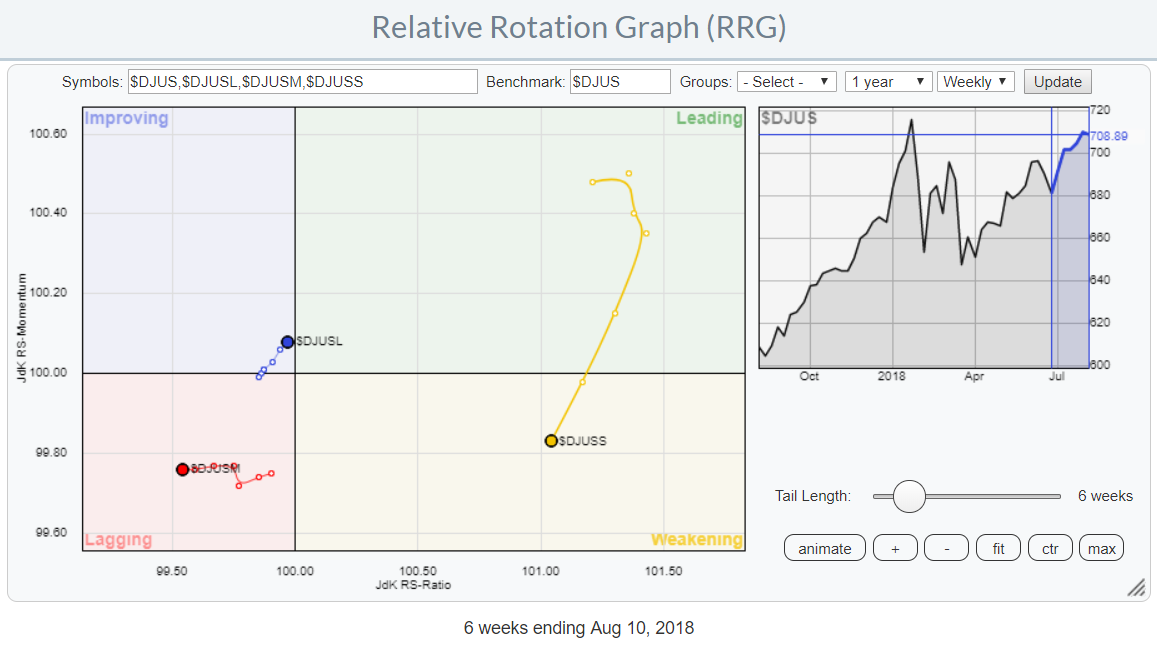 Every now and then I run a Relative Rotation Graph showing the rotation of various size and value/growth indices for the US market. They (can) give good insights into what areas of the stock market are in favor and which ones are rotating out of favor.
Every now and then I run a Relative Rotation Graph showing the rotation of various size and value/growth indices for the US market. They (can) give good insights into what areas of the stock market are in favor and which ones are rotating out of favor.
At the moment these rotational patterns are showing a loss of relative momentum for small-cap stocks and a rotation from growth to value, at least temporary.
Relative rotation of size segments in the stock market
The Relative Rotation Graph above shows the rotation for the three size-segments of the US market. Large-, Mid-, and Small-caps. The RRG uses the Dow Jones US index as the benchmark.
It is the long tail on the small-cap index that attracts the attention. The strong rotation from leading into weakening almost straight down indicates a rapid loss of relative momentum, something that signals caution.
The mid-cap index is already well inside the lagging quadrant, leaving only the large-cap segment at a positive RRG-heading and almost crossing over into the leading quadrant.
Hence, from a relative perspective, it is now time to prefer large-cap stocks over mid- and small-caps.
US mid-cap Index
 The chart of the US mid-cap index is sending the clearest signal of all three. The relative strength line broke below its horizontal support level in a very clear way, opening up the way for much more relative weakness.
The chart of the US mid-cap index is sending the clearest signal of all three. The relative strength line broke below its horizontal support level in a very clear way, opening up the way for much more relative weakness.
On the price chart, mid-caps have not been able to test their previous highs although they are still above the rising support line. A downward break of that rising support line will very likely accelerate the relative weakness even further.
US small-cap Index
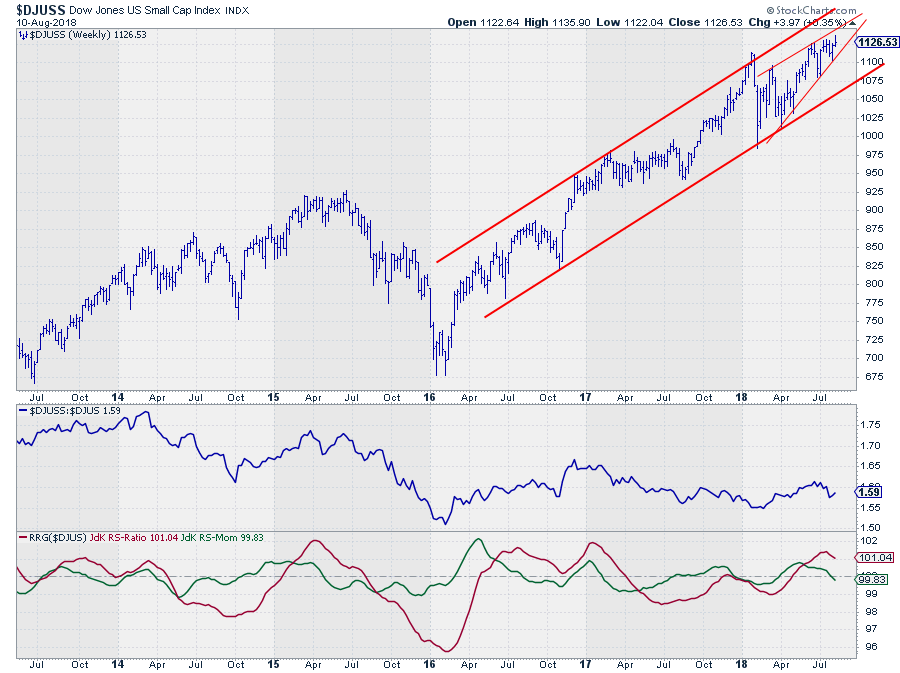 The chart of the small-cap index shows that the market has been testing resistance in the area of the previous high a few times over the past weeks but never managed to convincingly push higher meaning that selling pressure/resistance is building up in that area.
The chart of the small-cap index shows that the market has been testing resistance in the area of the previous high a few times over the past weeks but never managed to convincingly push higher meaning that selling pressure/resistance is building up in that area.
The long-term rising channel that is visible since 2016 is still intact but inside that channel, a rising wedge seems to be forming which is a pattern with negative implications and an expected break to the downside.
If such a downward break would occur, relative strength will also take a hit. For the time being the raw-RS line (blue line in the middle pane) is still moving more or less sideways but the RRG-Lines are already rolling over with JdK RS-Momentum crossing below 100 and RS-Ratio setting a peak. Any negative catalyst from the price chart will accelerate that process.
This makes the small-cap segment the segment with the most downward risk at the moment.
Growth vs. Value
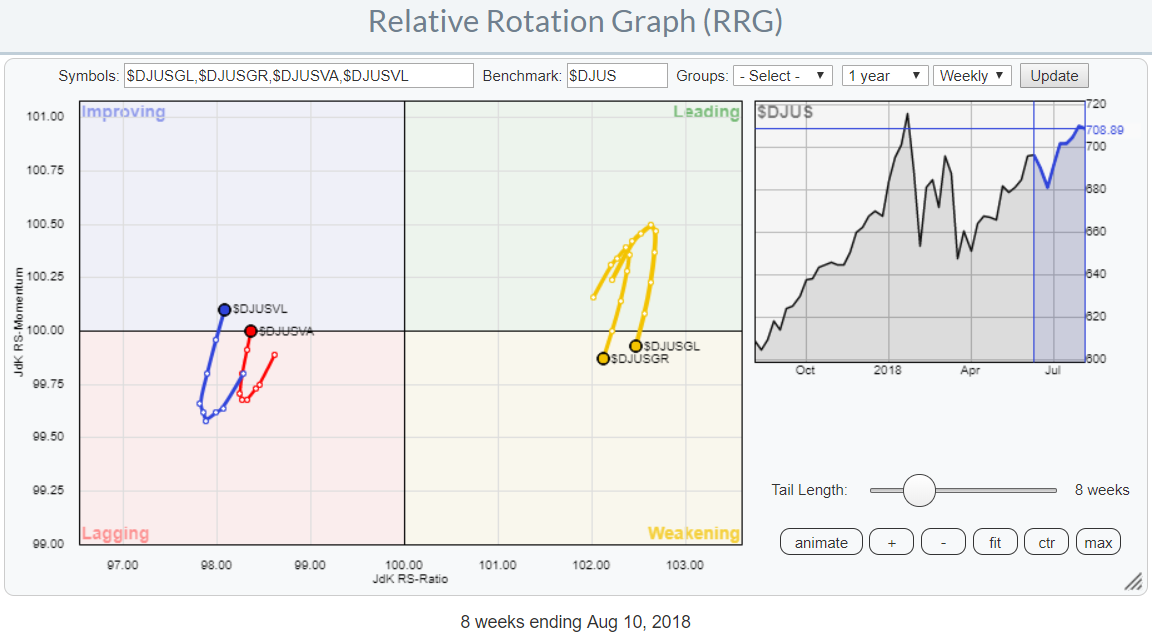 The RRG above shows the rotation of the US growth-, and value-indices as well as the US large-cap growth- and US large-cap value indices. Although growth is still on the right-hand, positive, side of the graph and value is on the left-hand negative side the recent rotation shows a move from growth into value.
The RRG above shows the rotation of the US growth-, and value-indices as well as the US large-cap growth- and US large-cap value indices. Although growth is still on the right-hand, positive, side of the graph and value is on the left-hand negative side the recent rotation shows a move from growth into value.
For the time being this is primarily a momentum driven move but the tails are already starting to move towards each other on the RS-Ratio scale causing an opposite rotation. This indicates an, at least a temporary, move in favor of value stocks over growth. This shift is most prominently visible in the large cap section of the market.
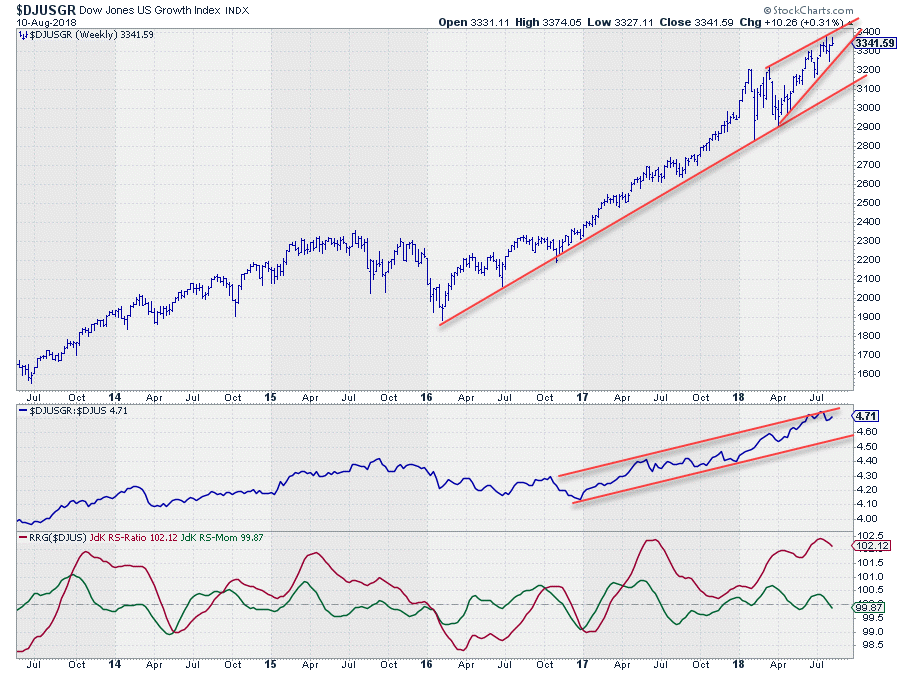
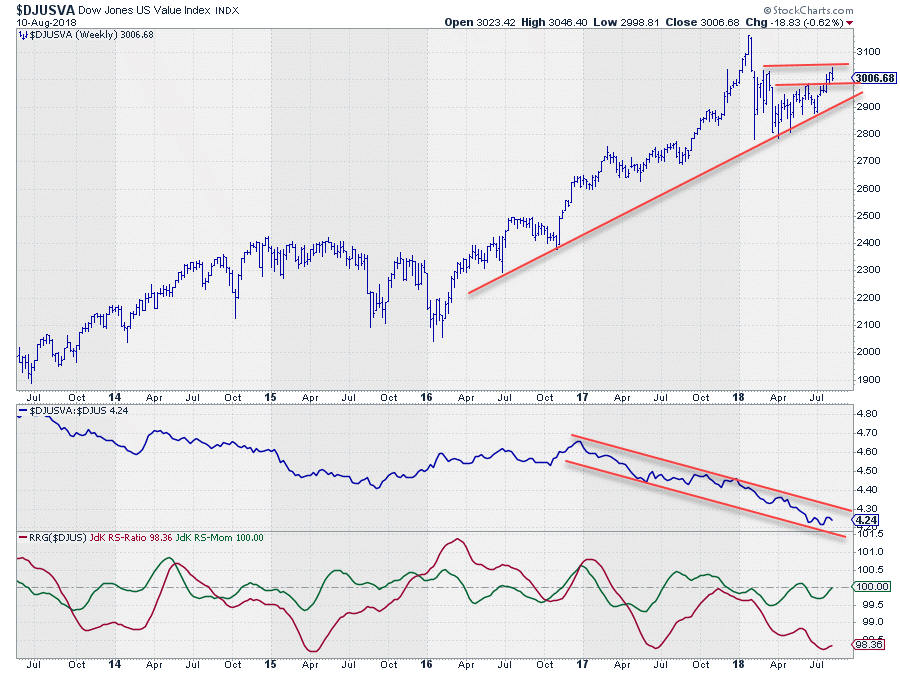 The charts of the growth- and value-indices in combination with their relative strength lines clearly show the better performance of growth over the past few months. Growth pushed to new highs a few times recently albeit only moderately and now seems to be forming something that can be seen as a rising wedge.
The charts of the growth- and value-indices in combination with their relative strength lines clearly show the better performance of growth over the past few months. Growth pushed to new highs a few times recently albeit only moderately and now seems to be forming something that can be seen as a rising wedge.
The value index bounced off the rising support line and cleared a first horizontal resistance level and is now pushing against a second barrier. Once that is cleared there will be more upside potential available towards the January high.
From a relative perspective, the upward channel for growth and the downward channel for value are fully intact and we see relative strength for growth bouncing against the upper boundary of that channel while RS for value is bouncing off the lower boundary of its channel. This is causing the opposite rotation on the RRG and at least a short-term move in favor of value over growth.
Given the distance from the center of the RRG and the duration of the existing trends, it seems worth it to keep an eye on this development. Especially in combination with the positive developments on the price chart for value against the negative developments for growth.
When these continue and lead to a downward break for growth and an upward break for value, the relative rotation that seems temporary for now could turn into a more sustainable move out of growth into value.
BTW: Please note that a weak momentum ranking for stocks does not automatically make them value stocks! It makes them... well..... stocks with weak momentum.
Momentum is a factor in itself and stocks can have high or low momentum. In another approach to looking at the market, stocks are labeled as growth- or value- based on the operational characteristics of the companies.
It is therefore perfectly possible for low momentum stocks to be growth stocks or high momentum stocks to be value stocks. Momentum is a factor that changes by the market movements. A growth stock will not all of a sudden become a value stock because of its market movement and vice versa. #justsaying
Let me know what you think of this usage of RRG in the comments below. If you would like to receive a notification when a new RRG blog article is published, simply "Subscribe" with your email address using the form below.
Julius de Kempenaer | RRG Research
RRG, Relative Rotation Graphs, JdK RS-Ratio, and JdK RS-Momentum are registered TradeMarks ®; of RRG Research
Follow RRG Research on social media:
If you want to discuss RRG with me on SCAN, please use my handle Julius_RRG so that I will get a notification.






